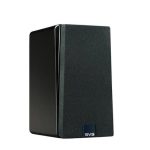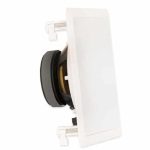Ceiling and in-wall speakers offer a unique way of setting up a sound system. They are a great way of adding sound to a room without taking extra space. They make a room look less cluttered. Moreover, they’re less visible, making them ideal for a minimalist room design. Also, you won’t have to worry about furniture placement around floor speakers. However, speaker wires that link up a sound source to the ceiling and in-wall speakers can make a room look extremely disorganized, especially when the wires are hanging all over the ceiling and across the walls. Thus, it’ll help to keep them less visible to make the room look more organized. Here’re some tips for hiding speaker wires on ceiling and in-wall speakers:
Camouflaging Speaker Wires with Paint
If you want to install ceiling and in-wall speakers, or you already have them installed, then it’s obvious that lengths of speaker wires will run up the walls and across the ceiling. You can make the wires less visible by painting them to match the color of the wall and ceiling. First, you’ll need to staple them onto the wall and ceiling. Doing so will align the wires neatly and keep them attached to the wall and ceiling. Then paint them to match the wall and ceiling color.
Tucking the Wires between Your Carpet and Baseboard

If a section of speaker wires has to run across the floor to reach in-wall speakers located on an opposite wall, then you can easily hide them by tucking them between your carpet and baseboard. Although you can run the wires under the carpet, they might be thick and make the carpet look bumpy. Thus, the best way to hide them is by tucking them along the space where the carpet meets the baseboard.
Using Cable Covers and Raceways
Cable covers and raceways are ideal for running speaker wires along the wall or ceiling in an organized manner. In this case, you’ll need to choose a cable cover/raceway that has an adhesive backing. The adhesive will allow you to stick the cable cover onto the wall or ceiling. If you can’t get a cable cover/raceway with a color that matches your wall or ceiling, simply paint them with a matching color.
Use the Flat Type Speaker Wire
The flat-type speaker wire is great for less visible wiring. This type of speaker wire comes with an adhesive backing for sticking onto the wall or ceiling. It’s typically thin, making it a perfect choice for camouflaging. Moreover, it’s flexible enough to run around corners. If your ceiling has a custom, irregular pattern, you’ll easily run the flat wire along the curves, thanks to its flexibility. You can also paint the side facing outward to match the color of the ceiling or wall.
Running the Wires above the Ceiling
If your home has a suspended ceiling, you can run the speaker wires above the ceiling. This method will make the speaker wires completely invisible. If you can be able to climb up the ceiling, then you can do it yourself and run the cables along the ceiling joists. If not, hire a professional to do it for you.
Snake the Wires through the Wall
If you need to completely hide the speaker wires for your in-wall speakers, simply snake them through the wall. In this case, you’ll drill a hole behind the sound source and snake it to the in-wall speaker. However, if you live in a rented house, you’ll need to get permission from the property management agency or landlord. It’s necessary to seek permission before proceeding with the project since you’ll be drilling holes through the drywall. Also, this task might need hiring the services of an expert. You can also do it yourself so long as you have the much-needed expertise and the right tools.
Conclusion
Ceiling and in-wall speakers are a great choice for a whole-house sound system. They’re space-saving and make it possible to maintain the existing room décor. By hiding the speaker wires of your ceiling and in-wall speakers, you’ll make the entire sound setup neater for enhanced room aesthetics. Hopefully, you’ll find these tips useful.
Michael Evanchuk is a San Francisco-based sound engineer with 20 years’ experience installing, troubleshooting, and repairing commercial, automotive, and household sound equipment. Evanchuk owns an auto stereo center, where he offers highly competitive car audio installation and repair services. He has written dozens of articles on different sound engineering topics, all of which have been published in leading journals, blogs, and websites.





